NRG Energy Bundle
Who Buys Power from NRG Energy?
In the ever-evolving energy sector, understanding NRG Energy SWOT Analysis is crucial for strategic success. The shift towards renewables and smart solutions has reshaped companies like NRG, making it vital to grasp their customer base. This article dives deep into the NRG Energy target market and the evolving landscape of NRG Energy customer profile.
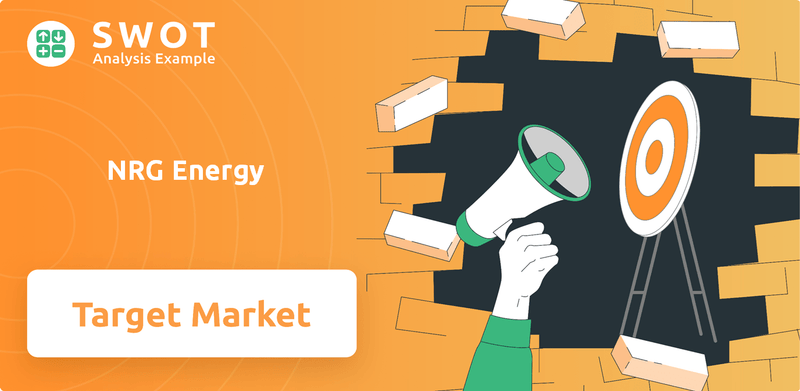
From its wholesale beginnings, NRG Energy now serves diverse customers, requiring a keen understanding of energy company customers and their needs. Analyzing the customer demographics and preferences is key to NRG's ability to compete and grow. This includes examining energy consumer behavior and how NRG adapts to different segments, ensuring it meets the demands of its varied target audience analysis.
Who Are NRG Energy’s Main Customers?
Understanding the customer base is crucial for any energy provider. For NRG Energy, this involves a deep dive into its primary customer segments. The company serves a diverse group, spanning residential and commercial sectors, each with unique needs and behaviors. Analyzing the customer demographics and target market allows for tailored strategies, ensuring effective service delivery and market penetration.
The customer profile of NRG Energy is multifaceted, shaped by factors like location, energy consumption habits, and preferences for energy sources. This analysis helps the company optimize its offerings and customer acquisition strategies. The energy consumer behavior varies significantly between residential and commercial clients, influencing the types of plans and services offered.
The primary customer segments of NRG Energy include both business-to-consumer (B2C) and business-to-business (B2B) clients. The B2C segment focuses on residential customers, while the B2B segment serves commercial and industrial clients. Each segment has distinct energy demands and preferences, requiring tailored approaches to meet their specific needs.
NRG Energy's residential customers are primarily served through retail brands like Reliant Energy, Direct Energy, and Green Mountain Energy. These customers are segmented based on age, income, and energy consumption patterns. For instance, customers of Green Mountain Energy often prioritize renewable energy options, which has seen significant growth in recent years.
The B2B segment includes a wide range of commercial and industrial clients, from small businesses to large corporations. These customers require customized energy management solutions, large-scale power supply, and sometimes on-site generation. The growth in this segment often aligns with industrial expansion and commercial development.
NRG Energy employs various strategies to segment its customer base effectively. This includes offering different pricing plans, such as fixed-rate and variable-rate options, to cater to different consumer preferences. The acquisition of Direct Energy in 2021 for approximately $3.6 billion significantly expanded its B2C footprint, diversifying revenue streams and building direct customer relationships.
The demand for renewable energy continues to rise, with renewable energy accounting for a substantial portion of new energy capacity. In 2024, the U.S. Energy Information Administration (EIA) reported that renewable energy sources accounted for approximately 22% of total U.S. electricity generation. NRG Energy is adapting to this trend by offering renewable energy options through its brands. The company's customer satisfaction surveys and retention strategies are key in maintaining a strong market position.
NRG Energy's customer demographics and target market are diverse, encompassing both residential and commercial sectors. Understanding the energy consumption habits and preferences of each segment is crucial for success. The company's strategic acquisitions and focus on renewable energy options reflect its adaptation to evolving market trends.
- B2C segment includes residential customers served by brands like Reliant, Direct Energy, and Green Mountain Energy.
- B2B segment includes commercial and industrial clients with diverse energy needs.
- The company focuses on customer acquisition strategies and retention to maintain market share.
- The demand for renewable energy is increasing, influencing NRG Energy's offerings.
NRG Energy SWOT Analysis
- Complete SWOT Breakdown
- Fully Customizable
- Editable in Excel & Word
- Professional Formatting
- Investor-Ready Format
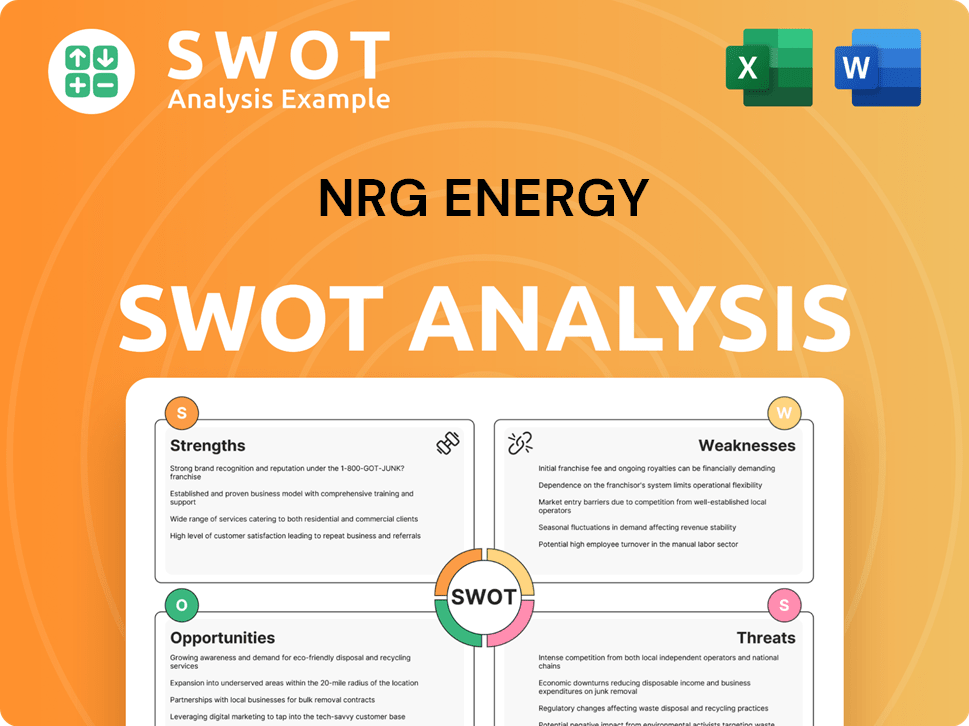
What Do NRG Energy’s Customers Want?
Understanding the needs and preferences of NRG Energy's customers is crucial for its strategic approach. This involves a deep dive into the customer demographics and the specific requirements of both residential and commercial clients. The company tailors its offerings to meet the diverse demands of its target market, ensuring customer satisfaction and loyalty.
The company's customer profile is shaped by a mix of factors, including cost, reliability, and sustainability. Residential customers often prioritize stable energy bills and consistent power, while commercial clients focus on operational efficiency and specialized energy solutions. This dual focus requires a flexible approach to product development and customer service.
NRG Energy's success hinges on its ability to meet these varied needs. By offering a range of services from basic electricity supply to advanced energy management, the company caters to a broad spectrum of consumers. This approach, combined with a commitment to innovation and customer feedback, allows NRG Energy to maintain a competitive edge in the energy market.
Residential customers often prioritize cost-effectiveness and reliability. They prefer fixed-rate plans for predictable bills and consistent power supply. Sustainability is also a growing concern, with many seeking renewable energy options.
Commercial and industrial clients focus on operational efficiency and cost management. They require reliable power and may seek sophisticated energy management systems. Long-term contracts and renewable energy integration are also important.
For residential customers, motivations include saving money and reducing environmental impact. Commercial clients are driven by the need to cut costs and improve sustainability. Both groups value reliable service and ease of use.
Customers show preferences through their choice of plans and their engagement with energy management tools. They are increasingly interested in smart home integration and demand response programs. This reflects a desire for control and efficiency.
Digital self-service options are highly valued by customers. They want to manage their accounts, monitor usage, and access information easily. This includes online portals and mobile apps.
A significant portion of customers are actively seeking renewable energy options. This includes both residential and commercial clients. The demand is driven by environmental concerns and corporate sustainability goals.
To effectively serve its diverse customer base, NRG Energy conducts thorough customer analysis. This includes understanding the energy consumption habits of customers and their preferences for different types of energy plans. The company uses this data to refine its offerings and improve customer satisfaction. For example, the company might analyze Marketing Strategy of NRG Energy to understand how different customer segments respond to various marketing messages and promotional offers.
- Customer Demographics: NRG Energy's customer base includes a wide range of demographics, from families to businesses.
- Energy Consumer Behavior: Understanding how customers use energy is crucial for offering tailored solutions.
- Target Audience Analysis: Analyzing the target audience helps in creating effective marketing campaigns.
- Customer Satisfaction Surveys: Feedback from surveys helps improve services and products.
NRG Energy PESTLE Analysis
- Covers All 6 PESTLE Categories
- No Research Needed – Save Hours of Work
- Built by Experts, Trusted by Consultants
- Instant Download, Ready to Use
- 100% Editable, Fully Customizable
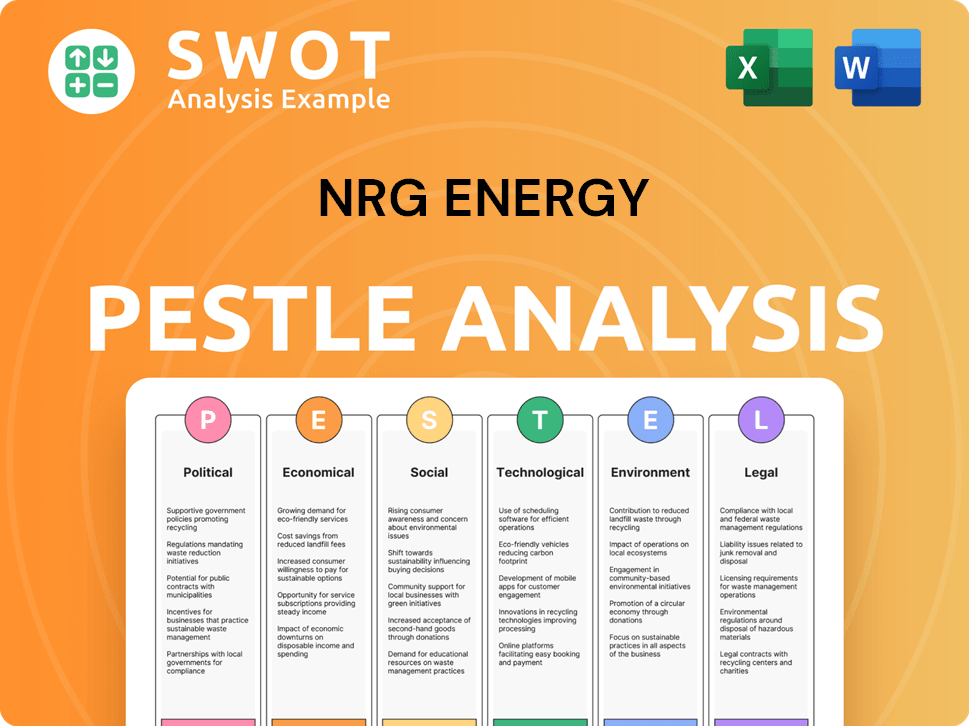
Where does NRG Energy operate?
The geographical market presence of NRG Energy is primarily focused on deregulated energy markets across the United States. This strategic focus allows the company to offer electricity and natural gas services directly to consumers where they have the freedom to choose their provider. Key areas of operation include Texas, the Northeast, and parts of the Midwest, with each region presenting unique opportunities and challenges in terms of customer demographics and energy consumption patterns.
Texas stands out as a particularly strong market for NRG, driven by its significant retail presence through brands like Reliant Energy. The company holds a substantial market share in Texas's competitive electricity market. Additionally, NRG has a robust presence in states such as Illinois, Massachusetts, and Ohio, where it serves both residential and commercial customers. These markets are crucial for NRG's overall revenue and growth strategy.
Understanding the nuances of each region is critical for NRG's success. Differences in customer demographics, preferences, and buying power are evident across these areas. For instance, states with hotter climates, like Texas, experience higher demand for air conditioning, which influences energy consumption patterns and the popularity of specific rate plans. Conversely, Northeastern markets, with colder winters, have different heating demands and a greater emphasis on natural gas supply. This regional variation drives NRG's localized approach to its offerings and marketing strategies.
NRG Energy's primary markets include Texas, the Northeast (Pennsylvania, New Jersey, New York), and parts of the Midwest. These regions are key for customer acquisition and revenue generation.
NRG segments its customer base by region, consumption patterns, and energy needs. This allows the company to tailor its products and services, enhancing customer satisfaction and retention. The company's customer profile is diverse, including residential, commercial, and industrial clients.
NRG employs region-specific marketing campaigns and local partnerships to enhance brand recognition and customer loyalty. For example, in Texas, Reliant Energy often sponsors local sports teams and community events.
Recent acquisitions, such as the Direct Energy acquisition in 2021, have bolstered NRG's presence in key retail markets across the U.S. and Canada, further diversifying its geographic distribution of sales and growth. This expansion is crucial for capturing a broader energy company customers base.
To effectively target its NRG Energy customer profile, the company conducts detailed target audience analysis. This involves understanding the specific energy needs and preferences of customers in different regions. Analyzing energy consumer behavior is crucial for developing effective marketing strategies and pricing plans. The company focuses on understanding what are the demographics of NRG Energy customers, including NRG Energy target market by age and NRG Energy customer income levels.
- Customer Location Data: Analyzing NRG Energy customer location data helps in identifying high-potential markets and tailoring services.
- Ideal Customer: Determining who is the ideal customer for NRG Energy involves assessing factors like energy consumption patterns and willingness to adopt new technologies.
- Segmentation: Understanding how does NRG Energy segment its customers allows for personalized service offerings and targeted marketing.
- Acquisition: NRG Energy customer acquisition strategies focus on attracting new customers through competitive pricing and promotional offers.
- Retention: NRG Energy customer retention strategies include loyalty programs and excellent customer service to maintain a loyal customer base.
- Competitor Analysis: Analyzing NRG Energy competitor customer analysis helps in understanding market dynamics and identifying opportunities.
NRG Energy Business Model Canvas
- Complete 9-Block Business Model Canvas
- Effortlessly Communicate Your Business Strategy
- Investor-Ready BMC Format
- 100% Editable and Customizable
- Clear and Structured Layout
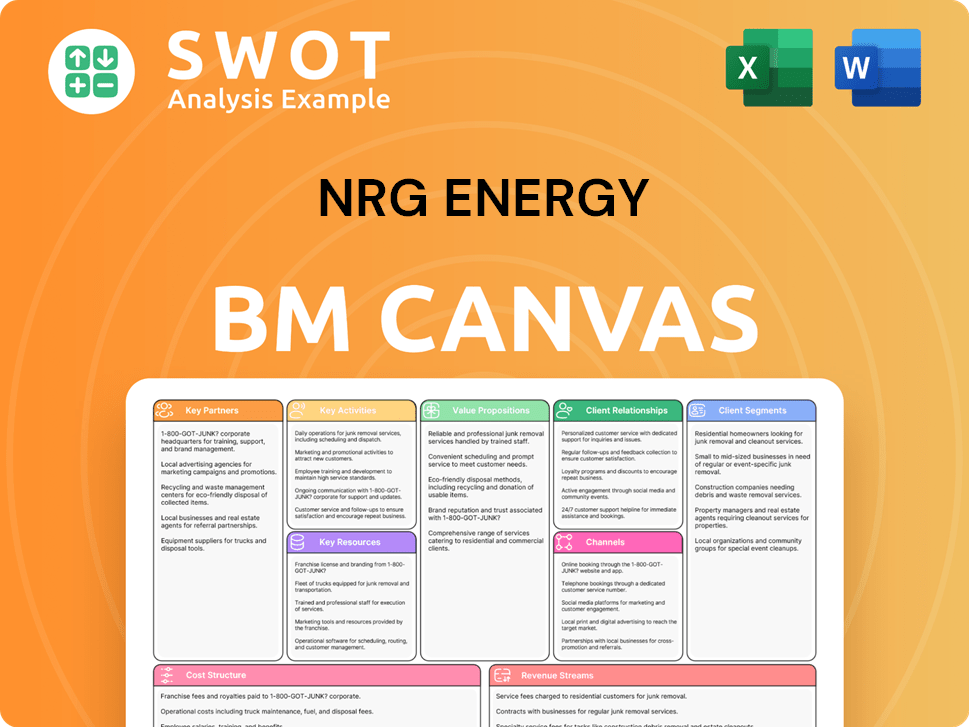
How Does NRG Energy Win & Keep Customers?
To acquire and retain customers, the company uses a multifaceted strategy. This approach combines various marketing channels, sales tactics, and customer-focused initiatives. The goal is to reach both residential and commercial clients effectively. This strategy is vital for success in the competitive energy market.
For customer acquisition, the company uses extensive digital marketing, including search engine marketing (SEM), social media advertising, and email campaigns. Traditional marketing, such as television and radio, is also used for brand awareness. Sales tactics include direct sales teams for large clients and online enrollment portals for residential customers. Referral programs and partnerships, like those with real estate agents, also contribute to acquiring new customers.
Customer retention focuses on building loyalty and maximizing customer lifetime value. The company offers loyalty programs, such as rewards for energy efficiency or timely payments. Personalized customer experiences are crucial, achieved through data analytics and CRM systems. After-sales service is emphasized, with robust customer support channels. The company also focuses on offering value-added services to deepen customer engagement and reduce churn. Changes in strategy over time have included a greater emphasis on digital engagement and personalized offers, driven by evolving customer expectations and the availability of advanced data analytics. These strategies aim to improve customer satisfaction and reduce churn rates in competitive energy markets.
The company uses digital marketing extensively for customer acquisition. This includes search engine marketing (SEM), social media advertising, and email campaigns. These strategies help reach potential residential and commercial customers effectively. This approach is crucial for attracting new clients in the digital age.
Traditional marketing channels like television, radio, and direct mail also play a role. These methods are particularly important for brand awareness in key markets. They help to build recognition and trust among potential customers. These methods complement the digital strategies.
Sales tactics include direct sales teams for large commercial and industrial clients. Online enrollment portals and call centers cater to residential customers. These varied channels ensure accessibility for different customer segments. They streamline the sales process and improve customer convenience.
Referral programs and partnerships, such as those with real estate agents, contribute to customer acquisition. These collaborations help expand the customer base through trusted sources. They leverage existing networks to reach new potential customers. This approach can be cost-effective.
The company's customer retention strategies are designed to foster loyalty and increase customer lifetime value. These strategies include loyalty programs and personalized experiences. After-sales service and value-added services also play a key role in keeping customers satisfied and engaged. The company continually adapts its strategies to meet changing customer expectations.
The company offers various loyalty programs to reward customer loyalty. These programs may include rewards for energy efficiency or timely payments. Loyalty programs are designed to encourage repeat business and reduce customer churn. These programs can significantly boost customer retention rates.
Personalized customer experiences are crucial for retaining customers. This is achieved through data analytics and CRM systems. These systems enable targeted communications and customized service offerings. Personalized interactions can greatly increase customer satisfaction.
Emphasis is placed on after-sales service to support customer satisfaction. This includes robust customer support channels and proactive communication. The goal is to address customer issues promptly and efficiently. Excellent service builds trust and loyalty.
Offering value-added services helps deepen customer engagement and reduce churn. Examples include smart home energy management solutions and home services. These services provide additional benefits and increase customer satisfaction. This enhances the overall customer experience.
Investment in digital platforms allows customers to manage accounts easily. Customers can track energy usage and access energy-saving tips. This enhances their overall experience and promotes customer engagement. Digital tools improve customer satisfaction and loyalty.
The company has adapted its strategies over time, focusing on digital engagement and personalized offers. This shift is driven by changing customer expectations and advanced data analytics. These adaptations help to stay competitive and meet customer needs. This ensures continued relevance in the market.
The company focuses on a blend of digital and traditional marketing for customer acquisition. Retention strategies include loyalty programs, personalized service, and value-added offerings. These strategies aim to improve customer satisfaction and reduce churn. The effectiveness of these strategies is crucial for success. For more details, see Growth Strategy of NRG Energy.
- Digital marketing (SEM, social media, email)
- Traditional marketing (TV, radio, direct mail)
- Direct sales and online enrollment
- Referral programs and partnerships
- Loyalty programs and personalized experiences
- Robust customer support and value-added services
NRG Energy Porter's Five Forces Analysis
- Covers All 5 Competitive Forces in Detail
- Structured for Consultants, Students, and Founders
- 100% Editable in Microsoft Word & Excel
- Instant Digital Download – Use Immediately
- Compatible with Mac & PC – Fully Unlocked
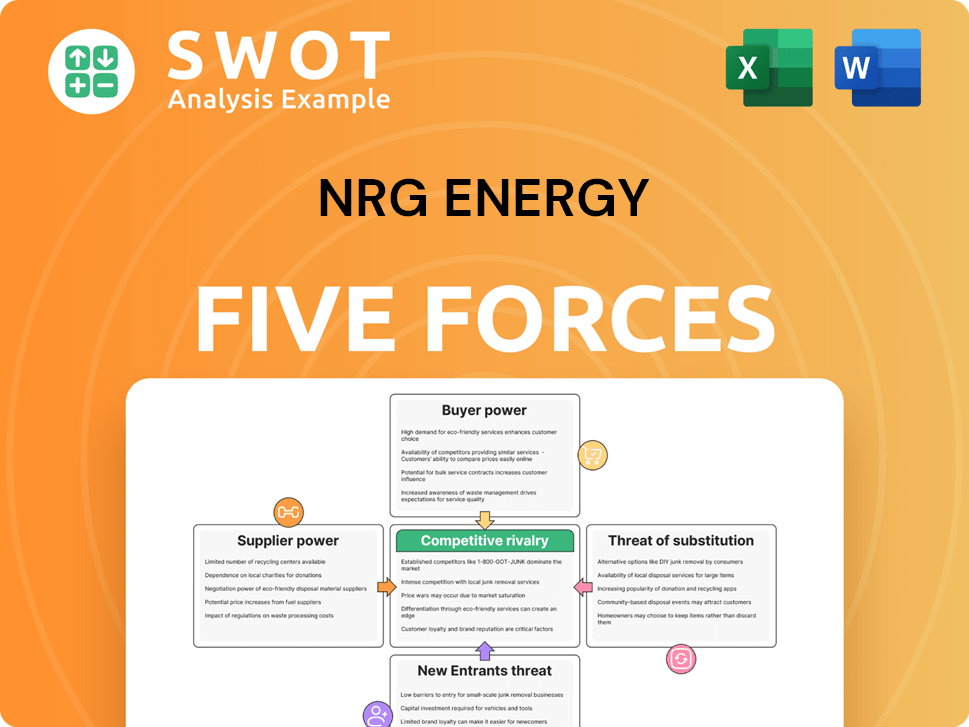
Related Blogs
- What are Mission Vision & Core Values of NRG Energy Company?
- What is Competitive Landscape of NRG Energy Company?
- What is Growth Strategy and Future Prospects of NRG Energy Company?
- How Does NRG Energy Company Work?
- What is Sales and Marketing Strategy of NRG Energy Company?
- What is Brief History of NRG Energy Company?
- Who Owns NRG Energy Company?
Disclaimer
All information, articles, and product details provided on this website are for general informational and educational purposes only. We do not claim any ownership over, nor do we intend to infringe upon, any trademarks, copyrights, logos, brand names, or other intellectual property mentioned or depicted on this site. Such intellectual property remains the property of its respective owners, and any references here are made solely for identification or informational purposes, without implying any affiliation, endorsement, or partnership.
We make no representations or warranties, express or implied, regarding the accuracy, completeness, or suitability of any content or products presented. Nothing on this website should be construed as legal, tax, investment, financial, medical, or other professional advice. In addition, no part of this site—including articles or product references—constitutes a solicitation, recommendation, endorsement, advertisement, or offer to buy or sell any securities, franchises, or other financial instruments, particularly in jurisdictions where such activity would be unlawful.
All content is of a general nature and may not address the specific circumstances of any individual or entity. It is not a substitute for professional advice or services. Any actions you take based on the information provided here are strictly at your own risk. You accept full responsibility for any decisions or outcomes arising from your use of this website and agree to release us from any liability in connection with your use of, or reliance upon, the content or products found herein.